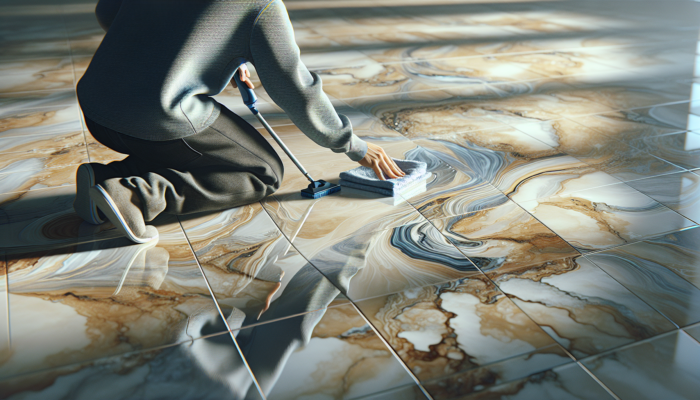Expert Techniques for Cleaning and Caring for Travertine Tile Like a Pro
Cleaning travertine tile requires careful planning and preparation to ensure the cleaning process is both effective and safe for these beautiful surfaces. By investing time in understanding the appropriate products to use, following safety protocols, and thoroughly assessing the condition of your tiles prior to cleaning, you will set a strong foundation for a successful cleaning experience. This preparatory work is essential to prevent any accidental damage while ensuring your travertine tiles retain their stunning appearance for years to come. Effective maintenance not only enhances the visual appeal of your tiles but also significantly prolongs their lifespan, making it a worthwhile investment for your home.
Gathering Essential Cleaning Supplies for Optimal Travertine Tile Care

Before embarking on your travertine cleaning journey, it is crucial to assemble all necessary cleaning supplies to ensure a smooth and efficient experience. Utilizing a pH-neutral cleaner is vital, as any acidic or overly alkaline solutions can etch and damage the delicate surface of the travertine. Look for cleaners specifically formulated for natural stone, as these products are designed to maintain the integrity and allure of your tiles. Additionally, soft cloths are indispensable; they are gentle enough to prevent scratches, with microfiber cloths excelling at trapping dirt and grime without causing abrasions.
A key component in your cleaning arsenal is a brush specifically designed for travertine cleaning. Opt for a soft-bristled brush that will effectively lift dirt and debris without scratching the stone’s surface. When sourcing these cleaning items, consider visiting local retailers or reputable online platforms that specialise in home improvement and cleaning supplies. This approach ensures that you are using high-quality products tailored for stone surface care, ultimately enhancing the durability and visual appeal of your travertine tiles.
Implementing Essential Safety Measures While Cleaning Travertine Tile
Many cleaning products contain harsh chemicals that can pose significant health risks if not handled with care. Always wear gloves to protect your skin from potentially harmful substances during the cleaning process. Additionally, ensuring a well-ventilated cleaning area is crucial, especially when using products with strong fumes. Open windows and activate fans to promote air circulation while you clean. If you are sensitive to chemicals or have respiratory issues, wearing a mask for added protection is highly advisable to ensure your safety throughout the cleaning process.
It is vital to meticulously read product labels to fully understand how to use each cleaning product safely and effectively. Familiarity with the products you are utilising can help avoid accidents and ensure a thorough cleaning process. Furthermore, being knowledgeable about first-aid measures in case of accidental skin contact with cleaning agents is a precaution that should never be overlooked, as preparedness can prevent minor accidents from escalating into serious issues, ensuring a safer cleaning environment.
Conducting a Comprehensive Evaluation of Your Travertine Tiles
Before initiating the cleaning process, it is essential to conduct a thorough inspection of your travertine tiles. Look for any cracks, chips, or signs of damage that may necessitate repair before you proceed with cleaning. This precautionary measure ensures that you do not inadvertently worsen any existing issues while applying cleaning tools or products, thereby avoiding further complications that could arise from neglecting these problems. By being proactive, you ensure that the cleaning process will be beneficial rather than detrimental to your tile’s condition.
If you encounter significant cracking or wear, it may be wise to consult with a professional before proceeding with your cleaning routine. Addressing these issues in advance will help safeguard the longevity of your tiles and uphold their aesthetic appeal. By understanding the condition of your tiles, you will be better equipped to determine whether a deep cleaning regimen or a gentler cleaning approach is required to effectively restore their beauty, ensuring they look their best at all times.
Daily Cleaning Techniques for Maintaining Immaculate Travertine Tiles

Implementing daily cleaning routines is critical for preserving the pristine beauty of your travertine tiles, particularly in high-traffic areas. Simple yet effective routines can considerably extend the lifespan and appearance of your tiles, preventing the accumulation of dirt and unsightly stains that can detract from their natural allure. By engaging in consistent cleaning practices, you can maintain the tiles' elegance and prevent damage over time.
Regular Sweeping and Dusting for Optimal Travertine Tile Maintenance
Regularly sweeping or dusting your travertine tiles is fundamental in maintaining their condition. Loose dirt, dust, and debris can scratch the surface, making the routine removal of these particles imperative. Utilise a soft-bristled broom or a microfiber dust mop to collect dirt without causing scratches. For homeowners in the United Kingdom, dedicating just a few minutes each day to sweep areas such as hallways or kitchens can yield a noticeable difference in your home’s overall cleanliness and aesthetic appeal. This commitment to cleanliness creates a welcoming environment for family and guests alike.
In addition to traditional sweeping methods, consider employing a vacuum cleaner equipped with a soft brush attachment to effectively reach corners and grout lines. This thorough approach helps prevent grime build-up and ensures that your tiles remain vibrant and visually appealing. By proactively engaging in daily cleaning, you can significantly reduce the need for more intensive cleaning later on, making it a wise investment of your time and effort for the long-term health of your tiles.
Enhancing Cleanliness with Mopping Using a Mild Detergent
Once you have finished sweeping or dusting, it’s time to engage in a more thorough cleaning through mopping. A mild, pH-neutral detergent mixed with warm water will effectively cleanse the surface without harming the travertine. It’s crucial to avoid harsh chemicals or acidic cleaners, as these can etch the stone over time, diminishing its beauty and integrity. Being mindful of your cleaning solutions is essential for the longevity of your tiles.
When mopping, use a damp mop rather than a soaking wet one. Excess water can seep into the grout and lead to long-term damage. For optimal results, mop the area in smaller sections, allowing you to concentrate on a limited area for a thorough clean. Finally, rinse the tiles with plain water to eliminate any soap residues, which could potentially leave unsightly streaks and detract from the overall appearance of the tile, ensuring that your tiles shine beautifully after cleaning.
Thoroughly Drying the Surface After Cleaning to Prevent Damage

After completing the mopping process, it is imperative to thoroughly dry the travertine surface to prevent the formation of water spots and mineral deposits. Use soft, absorbent towels or a dry mop to ensure no moisture lingers on the surface. In the United Kingdom, where humidity levels can be higher, taking extra care to dry the tiles is especially important to maintain their pristine condition and prevent mould and mildew growth. This attention to detail is crucial in upholding the beauty of your tiles.
Promptly drying the tiles is key to preventing the growth of mould or mildew, which can become problematic in damp climates. Patience is essential—spending a few extra minutes to ensure the surface is completely dry can save you from facing more significant cleaning challenges in the future. By being diligent in this step, you will ensure that your travertine tiles remain stunning and well-maintained, reflecting the care you dedicate to their upkeep and enhancing the overall aesthetic of your home.
Implementing Effective Spot Cleaning Techniques for Stains on Travertine Tiles
Inevitably, spills and stains will occur on your travertine tiles, and the quicker you address these issues, the better. For immediate response, use a soft cloth to blot (not wipe) any spills, as this helps absorb the liquid without further spreading the stain. For more stubborn stains, a mild cleaning solution can be applied to the affected area. It’s essential to avoid scrubbing too hard, as this could harm the delicate surface of the travertine, ensuring that your tiles remain in excellent condition.
In cases where a spill has dried, you can create a paste using baking soda and water to gently lift the stain. Apply the paste to the stained area, allow it to sit for a few minutes, and then rinse thoroughly with clean water. Acting quickly to treat stains is crucial, as it helps ensure that they do not become permanent features on your beautiful travertine tiles, preserving their elegance and appeal for years to come.
Regularly Vacuuming Grout Lines for Ideal Cleanliness
Regularly vacuuming grout lines is a beneficial practice to maintain a pristine appearance between tiles. Grout can be a hotspot for dirt and debris accumulation, leading to a dull appearance if left unchecked. Utilise a vacuum cleaner fitted with a crevice attachment to effectively reach into these tight spaces and eliminate any build-up that may compromise the aesthetic appeal of your tiles. This step is essential for a comprehensive cleaning routine.
This technique is particularly important in kitchens and bathrooms, where moisture can contribute to mildew growth if not adequately cared for. By consistently vacuuming grout lines, you ensure that your tiles remain clean and that the overall aesthetic of your travertine flooring is preserved. This small but impactful practice can significantly enhance the beauty of your home, making it feel fresh and inviting, allowing you to enjoy your living space fully.
Advanced Deep Cleaning Techniques to Restore Travertine Tiles
While daily cleaning is vital, periodically employing deep cleaning methods is equally essential to keep your travertine tiles looking their absolute best. These techniques target embedded dirt and tougher stains that regular cleaning may not eliminate, ensuring your tiles maintain their stunning appearance and shine. By incorporating these advanced methods into your cleaning routine, you can enhance the longevity and beauty of your tiles.
Utilising a Specialized Cleaner for Stubborn Stains
A specialised cleaner is optimal for addressing more stubborn stains and dirt build-up. These cleaners are specifically formulated for natural stone and can effectively lift dirt without damaging the surface. When using a travertine cleaner, it is vital to apply it according to the manufacturer’s instructions for the best possible results, ensuring that your tiles are treated with the utmost care.
Using a soft brush, gently scrub the tiles in a circular motion. This action removes dirt and rejuvenates the stone’s natural beauty. Pay particular attention to areas that endure higher traffic or have accumulated more grime, as these sections may require additional effort. Always rinse thoroughly with clean water afterward to remove any residues that may detract from the tiles’ luster and shine, ensuring your travertine remains brilliant and inviting.
Employing Steam Cleaning for Comprehensive Deep Cleaning of Travertine Tiles
Steam cleaning can be an excellent method for deep cleaning travertine tiles, provided that the steam is not excessively hot. High temperatures can damage the surface, so it is crucial to adhere to the manufacturer’s guidelines when using this method. This careful approach will help maintain the integrity of your tiles while achieving a thorough clean.
When utilising a steam cleaner, move slowly over the tiles, allowing the steam to penetrate the surface and lift any embedded grime. This method is particularly effective in kitchens and bathrooms, where rapid build-up occurs due to moisture and foot traffic. After steam cleaning, dry the surface thoroughly to prevent moisture from settling into the grout, which can lead to further issues and potential damage, safeguarding your travertine tiles for the long term.
Effectively Removing Grout Stains from Travertine Tiles
Grout stains can significantly detract from the overall appearance of your travertine tiles. A dedicated grout cleaner is ideal for tackling these stains. Apply the grout cleaner to the affected areas and allow it to sit for the time specified in the instructions. Then, use a small brush to gently scrub the grout lines without damaging the surrounding tiles. This careful attention will ensure your tiles look their best.
For persistent stains, consider creating a paste of hydrogen peroxide and baking soda. Apply the paste to the stained grout, allow it to sit for some time, and scrub gently. This method can effectively lift darker stains and restore the original colour of your grout, enhancing the overall appearance of your tiles and giving your flooring a fresh, new look that will impress anyone who visits your home.
Restoring the Shine to Travertine Tiles with Expert Polishing Techniques
After deep cleaning, restoring the shine to your travertine tiles is a wise choice. A specialised polish will enhance the stone’s natural beauty while providing a protective layer. Apply the polish using a clean cloth in circular motions to ensure even coverage across the surface, ensuring that your tiles are both beautiful and well-protected.
After application, allow the polish to sit for the duration specified by the manufacturer before buffing the tiles with a dry cloth. This process seals in the shine and protects the tiles from future stains or damage, ensuring that your travertine floors remain breathtaking for years to come. Regular polishing can significantly extend the life of your tiles, keeping them as stunning as the day they were installed while maintaining your home’s elegant look.
Strategies for Effectively Addressing Specific Stains on Travertine Tiles
Despite your best cleaning efforts, specific stains may still occur. Knowing how to address these issues effectively will help keep your travertine tiles looking flawless and well-maintained, enhancing the overall aesthetic of your home. Addressing stains promptly and effectively is essential for maintaining the beauty of your tiles.
Efficient Removal of Oil and Grease Stains from Travertine Tiles
Oil and grease stains can prove particularly challenging to remove from travertine surfaces. It is essential to act swiftly when you notice such a stain to prevent it from setting in. Begin by gently blotting the area with a soft cloth to absorb as much oil as possible. Avoid wiping, as this can spread the stain further across the tile, compromising its appearance.
To draw out the remaining oil, create a poultice by mixing baking soda with water to form a paste. Apply the poultice over the stain and cover it with plastic wrap to allow it to work overnight. Carefully remove the poultice in the morning and rinse the area with clean water. This method will help lift the stain effectively without damaging your travertine tiles, preserving their beauty and integrity for years to come, allowing you to enjoy their elegance.
Swiftly Addressing Wine and Juice Stains on Travertine Tiles
If not promptly handled, wine and juice stains can leave unsightly marks on travertine tiles. For these stains, mix equal parts of baking soda and water to create a paste. Apply the paste directly onto the stain and allow it to sit for approximately 30 minutes before gently scrubbing with a soft cloth. This method is effective in lifting stains while safeguarding the integrity of your tiles.
After scrubbing, rinse the area thoroughly with clean water to eliminate all residues. Ensure that the area is dried completely to prevent any lingering moisture from causing further issues. Regularly addressing stains like these will help keep your travertine tiles pristine and free from discoloration, maintaining their elegant look and appeal, ensuring your home remains inviting and beautiful.
Effectively Dealing with Ink and Dye Stains on Travertine Tiles
Ink and dye stains can be particularly stubborn on travertine. To treat these stains effectively, apply hydrogen peroxide directly to the stained area and allow it to sit for several minutes. Hydrogen peroxide acts as a mild bleach that can lift ink stains without damaging the stone, making it a great solution for tough stains.
After allowing the hydrogen peroxide to sit, rinse the area with clean water and dry thoroughly. You may need to repeat this process a couple of times for more stubborn stains. Always approach ink stains as soon as possible to increase the likelihood of complete removal, ensuring your travertine tiles look their best and remain aesthetically pleasing, preserving their charm for years to come.
Efficiently Removing Rust Stains from Travertine Tiles
Rust stains can occur on travertine tiles, particularly in areas where metal objects have been left in contact with the surface. To remove these stains, create a paste using lemon juice and salt. Apply this mixture directly onto the rust stain and allow it to sit for a few hours, giving the acid in the lemon juice sufficient time to work on the stain.
Once the time has elapsed, gently scrub the area with a soft cloth and rinse thoroughly with clean water. Ensure that the area is dried well to prevent any future staining. Regular maintenance and quick action upon spotting rust can help keep your travertine tiles in excellent condition, preserving their natural beauty and enhancing your home’s overall aesthetic, ensuring your flooring remains a stunning feature.
The Essential Importance of Sealing Travertine Tile for Longevity
Sealing your travertine tiles is critical in preserving their beauty and functionality. A high-quality sealant protects against stains and moisture, significantly prolonging the life of your flooring and ensuring it remains a stunning feature in your home. Sealing is an investment in the longevity and appearance of your tiles.
Key Considerations for Selecting the Right Sealer for Travertine Tiles
Selecting the appropriate sealer is vital for maintaining your travertine tiles. Opt for a penetrating sealer that is specifically designed for travertine. These sealers work their way into the stone, providing superior protection without altering its natural appearance. When shopping for sealers, look for breathable options that allow moisture to escape while preventing moisture from entering the stone, ensuring your tiles remain well-protected.
Local home improvement stores in the UK often carry a range of sealers, or you can explore online retailers for product reviews and recommendations. When making your selection, consider the specific needs of your tiles, such as their location in your home and exposure to moisture. This thoughtful approach will ensure you choose a product that best suits your travertine’s unique requirements and enhances its longevity.
Applying the Sealer for Maximum Protection and Effectiveness
Once you have selected the right sealer, it’s essential to prepare the surface by ensuring it is clean and dry. Apply the sealer evenly using a clean cloth or applicator, covering all areas without pooling or excessive application. This step is critical to achieving a uniform protective layer that will effectively guard your tiles against stains and moisture, ensuring they remain beautiful and functional.
Adhere to the manufacturer’s instructions regarding drying times and application methods. Working in small sections is advisable to ensure even application and prevent missed spots, guaranteeing that your tiles are comprehensively protected. After applying the sealer, allow the recommended curing time before using the area to ensure optimum effectiveness and protection for your travertine tiles.
Ongoing Maintenance for Sealed Travertine Tiles to Ensure Longevity
To maintain the seal on your travertine tiles, it is recommended that you reapply the sealer annually or according to the manufacturer’s guidelines. Regularly checking the integrity of the seal will help you identify when it’s time for reapplication, ensuring your tiles remain protected from stains and moisture. This proactive approach is essential in preserving the beauty of your flooring.
In addition to sealing, continue your regular cleaning routines to ensure your travertine stays in top condition. Combining sealing with diligent cleaning practices can effectively protect your investment in travertine tiles, ensuring they remain a beautiful and functional home feature for many years to come, allowing you to enjoy their elegance and charm.
Troubleshooting Common Issues with Travertine Tiles for Effective Care
Even with the best care, various issues may arise with your travertine tiles. Knowing how to address these problems will significantly assist in maintaining the beauty and longevity of your flooring. Being prepared for common issues can help you keep your tiles looking their best.
Restoring Shine After Etching and Dullness on Travertine Tiles
Etching, which can be caused by acids or harsh cleaning products, may dull the appearance of your travertine tiles. To restore their shine, use a specialised polishing powder. Apply the powder according to the manufacturer’s directions, typically by mixing it with water to form a paste that can be easily applied.
Gently buff the area in a circular motion using a clean, soft cloth. This process revitalises its natural luster, helping to regain its original shine. Regular polishing can help keep your travertine looking its best while offering protection against future damage. This routine maintenance is crucial for preserving the beauty of your tiles over time, ensuring they remain a cherished feature of your home and enhancing the overall aesthetic.
Effectively Repairing Cracks and Chips in Travertine Tiles
Cracks and chips can develop over time due to heavy use or impact. To address these issues effectively, consider investing in a travertine repair kit. These kits typically include a filling compound that matches the colour of your tiles, allowing for seamless repairs that restore the integrity of the flooring. Such repairs not only enhance the appearance of your tiles but also prevent further damage.
Carefully follow the instructions provided with the kit to fill in the cracks or chips. After the repair has cured, you can lightly sand the area to make it flush with the surrounding tile. This simple yet effective repair can enhance the overall appearance of your tiles and prolong their lifespan, ensuring your flooring remains a beautiful feature of your home for many years to come.
Addressing Discoloration on Travertine Tiles for a Fresh Look
Discoloration is another common issue that can arise from spills, stains, or general wear and tear. To address this, use a gentle travertine cleaner and a soft brush to scrub the affected areas. Be patient, as it may take several attempts to see significant improvement in the tile’s appearance. Consistency is key to restoring the natural beauty of your tiles.
If the discoloration is more pronounced, consider consulting with a professional cleaner who has experience working with natural stones. Regular maintenance and quick responses to stains can help prevent discoloration from becoming a long-term issue, preserving the stunning appearance of your travertine tiles while maintaining their value and charm, ensuring your home remains inviting and beautiful.
Frequently Asked Questions About Caring for Travertine Tiles
What is the recommended frequency for cleaning my travertine tiles to keep them looking great?
To effectively remove dirt and debris, it is advised to clean travertine tiles at least once a week, alongside daily sweeping to maintain their pristine condition and appearance. This routine will help ensure that your tiles remain beautiful and functional.
Is it safe to use vinegar as a cleaning agent for travertine tiles?
No, vinegar is acidic and can cause damage to travertine tiles. Always opt for pH-neutral cleaners that are specifically designed for natural stone to ensure their longevity and maintain their beauty.
Is sealing truly necessary for my travertine tiles?
Yes, sealing is essential. It provides a protective barrier against stains and moisture, significantly prolonging the lifespan of your tiles and preserving their beauty for years. This investment is crucial for your flooring's longevity.
How long can I expect the sealer to remain effective on my travertine tiles?
Most sealers have a lifespan of six months to a year, depending on usage and the level of moisture exposure in your home, so regular checks are advisable to ensure ongoing protection.
If I accidentally etch my travertine tile, what steps should I take to rectify the situation?
You can utilise a travertine polishing powder to restore the shine and reduce the visibility of etching, helping to rejuvenate your tiles effectively and maintain their beauty.
Can I safely use a steam cleaner on my travertine tiles without causing damage?
Yes, but you must ensure that the steam is not excessively hot to avoid damaging the tiles during the cleaning process. Proper temperature management is essential for safe cleaning.
What should I do to effectively deal with stubborn stains on my travertine tiles?
For particularly stubborn stains, consider using a poultice made from baking soda and water, or consult a professional cleaner who specialises in natural stone care for effective solutions that will preserve your tiles.
What is the best method to thoroughly dry travertine tiles after cleaning?
Utilise soft, absorbent towels or a dry mop to thoroughly dry the tiles after cleaning to prevent the formation of water spots and ensure a pristine finish on your tiles, maintaining their beauty.
How can I maintain the shine of my travertine tiles over time?
Regular polishing with a travertine-specific polish can help maintain the shine and protect the surface from damage and discoloration, ensuring your tiles look their best.
Is it safe to use regular floor cleaners on travertine tiles?
No, avoid using regular floor cleaners, as they may contain harmful chemicals for travertine. Always use products specifically formulated for natural stone care to protect your tiles and their finish, ensuring their longevity.
The post How Do You Clean Travertine Tile – A Comprehensive Guide appeared first on https://tilecleaningsurrey.co.uk
The Article Cleaning Travertine Tile: Your Essential Guide appeared first on https://fabritec.org
The Article Travertine Tile Cleaning: The Ultimate Essential Guide Was Found On https://limitsofstrategy.com

